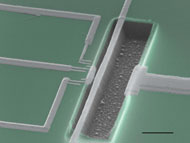Yael Petar

According to quantum mechanics, it is impossible to measure the properties of small particles without affecting them. This limitation affects the degree of knowledge regarding the material and prevents the particles from ceasing to vibrate. Now physicists have turned that inevitable disorder to their advantage and used it, paradoxically, to decelerate a tiny vibrating string.
Even the simplest quantum devices may lead to new information technologies and other developments. Researchers are now experimenting with tiny strings, or "nanomechanical resonators", which vibrate like nano-sized guitar strings, which when cooled to a temperature close to absolute zero, these strings are supposed to behave in a quantum-like manner. Once this happens, the researchers hope to then bring the string into a bizarre quantum state where the string is literally bent into two different paths at the same time. Such a string may serve as a "bit" in the sense that its encoding will be both 0 and 1 at the same time. However, they never succeeded in cooling a string to the required temperature of a few thousandths of a degree Kelvin.
Now, Akshay Nick of the University of Maryland, College Park, Keith Schwab of Komal University, and colleagues have found a new way to cool a resonator. The researchers first had to detect the state of the string using a superconducting single-electron transistor (SSET), which contained a tiny patch of superconducting metal parallel to the string. Electrons bounced into the patch at one end and bounced off it at the other. The group of researchers passed an electrical voltage between the string and the patch, which caused each movement in the string to change the rate at which electrons flowed through the transistor, thus allowing the researchers to detect the oscillation of the string.
In a normal situation, the bouncing electrons would push the string by changing the electrical charge of the patch and thus the force acting between the patch and the string. But Schwab and his colleagues found that when they applied an additional electric voltage aimed at the patch, the electrons did not have enough energy left to jump to it. In this case the electrons have drawn some energy from the beam flow to help themselves continue. The transferred energy conditioned the string and cooled it from 0.55 degrees Kelvin to 0.3 degrees Kelvin, according to the researchers' report to Nature magazine.
"This is a tremendous achievement," says Konrad Lehnert, a physicist from JILA - a laboratory managed by the National Institute of Standards and Technology at the University of Colorado, Boulder. "Experiments with a single-electron transistor are difficult". Robert Noble, a physicist at Queen's University in Kingston, Canada, says physicists "might be able to use this as a tool to cool resonators to the point where we can see quantum mechanics in a macroscopic device."
https://www.hayadan.org.il/BuildaGate4/general2/data_card.php?Cat=~~~589924025~~~95&SiteName=hayadan
